Dollina

|
| Certo Dollina II image by Remo Boretti (Image rights) |
The Dollina is a series of 35mm folding cameras produced by the German maker Certo based in Dresden. There were three generations of Dollina, each with a different body.
Contents
The first generation: Dollina, Dollina 0, Dollina I, Dollina II
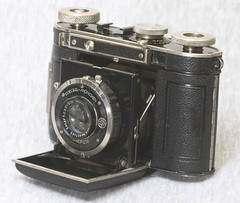
|
| Dollina I, with Xenar f/2.9 image by Jack Hufnagel (Image rights) |

|
| Certo Dollina 0 with Art Deco faceplate image by Rick Soloway (Image rights) |
The chassis
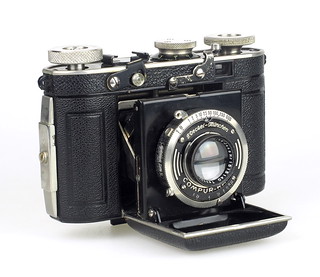
|
| Certo Dollina base model from 1935 image by Christoph Batz (Image rights) |
All three of these models are built on the same frame, a compact strut-folding, self-erecting chassis made of sturdy metal. The bed, which is molded bakelite covered in leatherette, releases via a catch above it on the camera front. Film transport is left-to-right. There is a frame counter on the top plate. The sprocket wheel, which oddly has only three teeth, is operated by a button on the front of the camera; when the button is pressed, the film can advance one frame before the sprocket locks again; a nearby sliding control unlocks and allows the button to move from side to side, which manually changes the number shown in the frame counter. The rewind release is operated by pulling out the advance knob and turning it back clockwise a partial turn, where it latches, allowing the film to rewind freely. The viewfinder is a simple reverse-telescope, built unobtrusively into the top plate at the left side. On all generation-1 Dollinas, the shutter release is on the shutter body; there is no mechanical linkage between the shutter and the rest of the camera.
When the camera was launched in 1935 there was only one model at first, which was simply called Dollina and today is referred to as the base-model. It can be distinguished from its successors by the missing cover of the mechanics above the lens. About 1,000 units of this base model have been built before it became the Dollina I. By about early 1936 Certo decided to spread its portfolio and introduced the Dollina 0 as a low cost version (3-element lenses, simple shutters, no body focussing), the Dollina I would be the mid-range version (Compur shutter, no rangefinder), and eventually they offered the high end version Dollina II (Compur Rapid shutter, coupled range finder, high end lenses, e.g. Xenon f/2)[1].
The Dollina I and II both have unit focusing operated by a knob on the top of the body. This moves one pair of struts, causing the front standard to move in or out with the struts pivoting in a scissor-like fashion. The camera can be collapsed with the focus set to any distance, and the distance can be safely adjusted even with the camera closed; in fact, it is possible to focus the camera normally before opening it.
The tripod bushing is on the bottom left. It is not the modern standard size, though screw-in adapters exist. Both of the manual focus Dollinas of this generation have a cold shoe, ostensibly for an accessory rangefinder.
Dollina (base model) and Dollina I
The first model from 1935 was just called the Dollina, a horizontal-bed folding 35mm camera with a simple viewfinder. The shutter was either a Compur 300 or the then brand new Compur Rapid (1/500s). With the introduction of the Dollina 0 in 1936 and a little later the Dollina II this type became the Dollina I and was only offered with the Compur 300 since. The lenses included:
- Meyer Trioplan 5cm f/2.9 (3 element)
- Schneider Radionar 5cm f/2.9 (3 element)
- Schneider Xenar 5cm f/2.8 (4 element)
- Schneider Xenar 5cm f/2.9 (5 element)
- Steinheil Cassar 5cm f/2.9 (3 element)
- Carl Zeiss Tessar 5cm f/2.8 (4 element)
Dollina 0
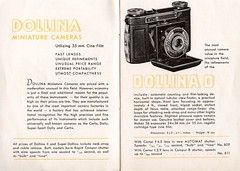 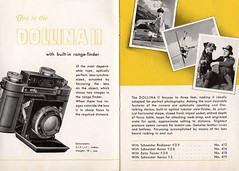
|
| Dollina 0 and Dollina II in a Certo catalogue (Image rights) |
The Dollina 0 was a cheaper version, with 3 element lenses and front cell focusing. The choice of lens and shutter for the Dollina 0 included:
- Certar 5cm f/4.5 with Automat 25-100
- Certar 5cm f/4.5 with Vario 25-100
- Certar 5cm f/4.5 with Pronto 200
- Certar 5cm f/2.9 with Compur 300
Dollina II

|
| Dollina II image by Laszlo Gerencser (Image rights) |
The Dollina II was an enhanced version of the Dollina I, with a coupled rangefinder unit added above the top plate and no cold shoe. There are no differences in the main body beside the screwholes to mount the rangefinder, though there are now different lens and shutter options than the Dollina I. The focus on this model is also operated by the focusing knob on top, the shaft of which is now longer, as it passes through the rangefinder on its way into the top plate.
The viewfinder and rangefinder windows are separate, with the latter being on the rangefinder body. The rangefinder displays a split image, with the lower, moving half being tinted amber, similar to the Argus C3 rangefinder, but dimmer and with a shorter effective base. The rangefinder is operated by a cam on the underside of the focus knob, which pushes a stud on the top of the rangefinder body forwards as the focus approaches infinity. This cam is exceedingly delicate, as it consists of a piece of sheet metal cut and folded to form a cam shape, onto which a strip of sheet metal is bent and soldered to form the working surface. It is possible for the solder to fail, in which case only a set of metal fingers on the first piece of metal hold the strip in place. If the knob is turned too forcefully in this condition, these fingers too may release the strip, causing the cam to fail, though this can be repaired if the fingers are not broken. Calibration is normally set by disassembling the knob and resetting the cam so that the operation of the rangefinder coincides with correct focus settings on the camera.
The Dollina II existed in black finish (earlier version) and in chrome finish (later version). The Dollina II was a mid priced camera; in 1938, a Schneider Xenon lensed model sold in New York for $57.50 US, or about $859 Us in 2007 terms. This was about half the price of a Xenon lensed Retina II or Weltini.
The shutter was either a Compur 300 or a Compur-Rapid 500 with PC socket. Upon first encountering the latter, many photographers will assume that it is broken, in that it seems impossible to set the shutter to 1/500th. However, there is a stiff auxiliary spring inside the shutter that must be tensioned by rotating the speed dial firmly to 1/500th before the top speed can be used. It will not damage the camera to turn the selector to 1/500th, in spite of the heavy resistance: this resistance is normal and necessary. Note well that the cocking lever will also be substantially harder to move at 1/500th, as it is now working against both the normal spring and the auxiliary.
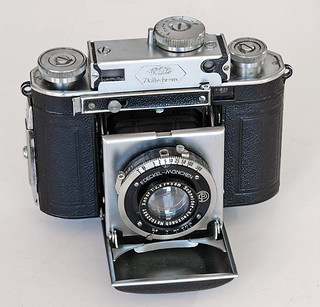
|
| Dollina II re-badged as HAFA Dollychrom 1935 image by Geoff Harrisson (Image rights) |
The choice of lenses for the Dollina II included:
- Schneider Radionar 5cm f/2.9 (3 element)
- Schneider Xenar 5cm f/2.9 (4 element)
- Schneider Xenar 5cm f/2.8 (5 element)
- Schneider Xenon 5cm f/2 (6 element)
- Schneider Xenon 4.5cm f/2 (6 element)
- Steinheil Cassar 5cm f/2.9 (3 element)
- Carl Zeiss Jena Tessar 5cm f/2.8 (4 element)
The Dollina III
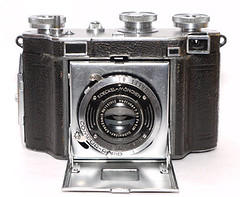 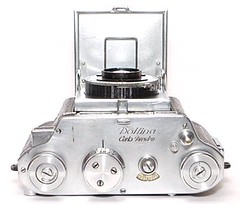
|
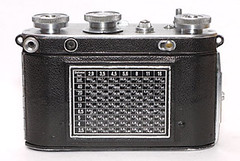 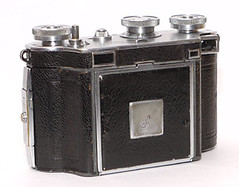
|
| Certo, Dolina III, Compur-Rapid shutter, Schneider Radionar f2.9/5cm lens. Images by yalluflex. (Image rights) |
The Dollina III was a high-end model, with a focusing wheel above the top plate like the previous models, and a coupled rangefinder integrated in a new body with a baroque shape. The folding bed is a flat square plate, and the two sides of the body protrude together to leave room for the lens and the rangefinder. The shutter was either a Compur 300 or a Compur-Rapid 500. The choice of lenses for the Dollina III included:
- Schneider Radionar 5cm f/2.9
- Schneider Xenar 5cm f/2.8
- Schneider Xenon 5cm f/2
- Steinheil Cassar 5cm f/2.9
- Carl Zeiss Jena Tessar 5cm f/2.8
The Dollina III was short lived and replaced by the Super Dollina, and today it is the most uncommon of the Dollina models.
The last generation: Super Dollina, Super Dollina II

|
| Super Dollina, with Xenar 5cm f/2.8 image by Paulo Moreira (Image rights) |
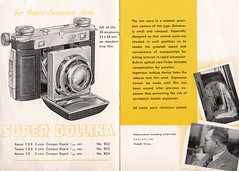
|
| Super Dollina in a Certo catalogue (Image rights) |
The Super Dollina replaced the Dollina III as the top of the range. It also had a coupled rangefinder integrated in the body, but this new body was more rounded and compact, similar to the Dollina I and II. The viewfinder and rangefinder windows were separated. The focusing wheel was sticking out of the right side of the top plate. The Super Dollina had two thick buttons for advance and rewind, and was made at least until the war. The shutter was either a Compur 300 or a Compur-Rapid 500. The choice of lenses for the Super Dollina included:
- Friedrich Doppel Anastigmat Corynar 5cm f/2.7
- Meyer Trioplan 5cm f/2.9
- Schneider Xenar 5cm f/2.8
- Schneider Xenon 5cm f/2
- Steinheil Cassar 5cm f/2.9
- Carl Zeiss Jena Tessar 5cm f/3.5
- Carl Zeiss Jena Tessar 5cm f/2.8
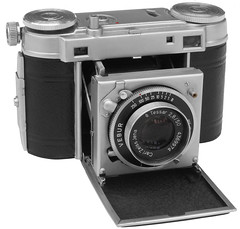
|
| Super Dollina II, with Tessar f/2.8 image by Alf Sigaro (Image rights) |
After World War II, it was replaced by the Super Dollina II with slim buttons for advance and rewind. The shutters on the Super Dollina II included:
- Cludor 200
- Vebur 250
- Compur-Rapid 500
- Synchro-Compur 500
The choice of lenses for the Super Dollina II included:
- Ludwig Meritar 50mm f/2.9
- Rodenstock Heligon 50mm f/2 (probably for exportation, together with a Synchro-Compur 500)
- Carl Zeiss Jena Tessar 50mm f/3.5
- Carl Zeiss Jena Tessar 50mm f/2.8
The Super Dollina II was in production for a very long time, until the beginning of the 1970s. It was also sold under the name Super 35.
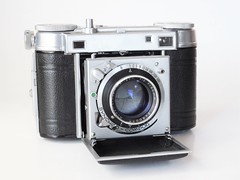 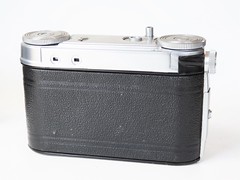 
|
| 1951 Certo Super Dolina-II , Rodenstock Heligon f2/50mm lens in Synchro-Compur shutter Images by yalluflex. (Image rights) |
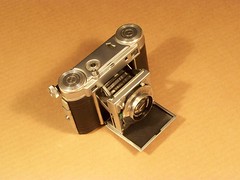 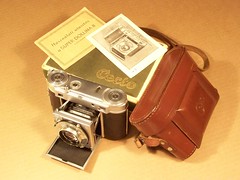
|
 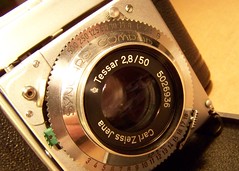
|
| Super Dollina II, Tessar f/2.8 images by Laszlo Gerencser (Image rights) |
The offshoot: Durata, Durata II
The Durata was a less expensive variant of the Super Dollina II produced after the war in 1949 [2] , without a rangefinder. The first model had a folding optical finder. The shutters included the Prontor II. The lenses for the Durata included:
- Rodenstock Trinar 4.5cm f/3.5
The Durata II was the following model in 1951 [3] , with a top plate integrating the viewfinder, and bearing a closer resemblance to the Super Dollina II. The shutters included the Cludor 200. The lenses for the Durata II included:
- Meyer Trioplan 50mm f/2.9
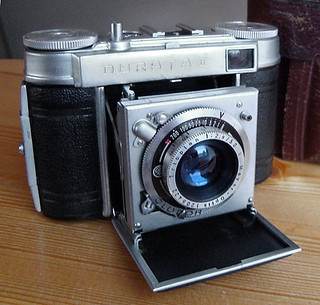
|
| Certo Durata II, Trioplan f/2.9 lens Photo by eBayer lenses_worldwide (Image rights) |
Notes
- ↑ Dresdner Kameras (in German)
- ↑ McKeown, James M. and Joan C. McKeown's Price Guide to Antique and Classic Cameras, 12th Edition, 2005-2006. USA, Centennial Photo Service, 2004. ISBN 0-931838-40-1 (hardcover). ISBN 0-931838-41-X (softcover). Page 196.
- ↑ McKeown, James M. and Joan C. McKeown's Price Guide to Antique and Classic Cameras, 12th Edition, 2005-2006. USA, Centennial Photo Service, 2004. ISBN 0-931838-40-1 (hardcover). ISBN 0-931838-41-X (softcover). Page 197.
Links
General links
In English:
In German:
In Japanese:
Repairs
In Japanese:
Manuals and documentation
In English and Hungarian:
- Hungarian manual for the Super Dollina II (pdf format), with an English translation by Laszlo Gerencser